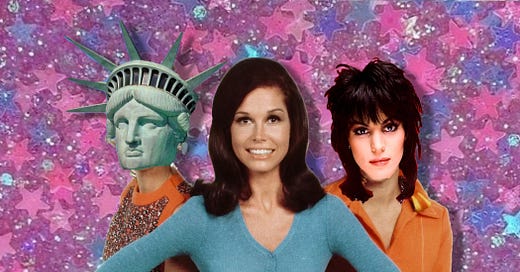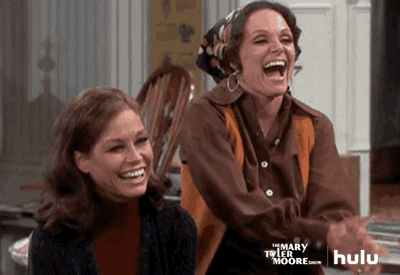30 was the year of three firsts: living on my own, watching The Mary Tyler Moore Show, and sleeping with an aluminum bat beside my bed.
At that point I had been in The City for six years, enduring two generations of roommates in the forced intimacy of a railroad-style apartment. I felt justified in claiming the bachelorette pad, but terrified about what happens when you’re all alone. Luckily I knew Mary Richards, the capital-M Main Character of The Mary Tyler Moore Show, did it first. So one night I sat cushioned on my red Simpsons couch, smoking tiny pink joints, waiting for that immortal line to drop. “Who could turn the world on with her smile?”
And it didn’t happen.
Look, I’m not trying to gaslight you, these days most people know MTM’s theme song, “Love is All Around,” more than the show itself. The original track is done by Sonny Curtis, though you’ve probably heard the excellent Joan Jett cover in a film or two. And of course, of course, it caps off with the image of Mary tossing her hat in the air, a living embodiment of Lady Liberty, to the triumph of, “you’re going to make it after all!” [FREEZE FRAME].
But the first season of Mary Tyler Moore used different lyrics, ones that spoke to the precarious voyage Mary was embarking on:
“How will you make it on your own?
This world is awfully big
And girl this time you’re all alone”
So I’m sitting there, in my plume of smoke, like, “The fuck is this? Me getting cornered at the open bar of a family wedding?” The original lyrics cast a sense of doubt on a woman’s capacity for solo success, even ending with “you might just make it after all.” Yikes. I nonetheless joined the Mary Richards on her journey, became a *passionate* Mary Tyler Moore fan, and learned what “making it after all” really meant.
So believe it or not, the glass ceiling was markedly lower in America 1970
Let me put it this way. The original show concept was that Mary Richards was a 30-year-old divorcée starting her life over, and CBS was clutching their pearls over this. The first gripe was that people would think she divorced Dick Van Dyke (Mary Tyler Moore had previously won hearts as pants-wearing housewife Laura Petrie in The Dick Van Dyke Show). Then a researcher was brought in to share that “Americans won’t tolerate divorce in a lead of a series any more than they will tolerate Jews, people with mustaches, and people who live in New York.” 😬
I often think about the audaciousness of that claim, and not just when I have a strip of bleach above my upper lip. It just goes to show that TV did not have open arms for diverse leads, and Mary Richards was switched to being single, not divorced. This still placed the Mary Tyler Moore Show in uncertain territory, since the only other precedent for an unmarried female lead was Marlo Thomas in That Girl. The lyrics reflect that uncertainty of the future. For Mary Richards. For Mary Tyler Moore. For the show itself.
So get back on the couch and let’s try this again.
In the pilot episode, 30-year-old Mary Richards moves to Minneapolis to start a new life. She’s recently bailed on her med student boyfriend, realizing he’d probably never marry her. As a personality, especially in a modern lens, Mary Richards doesn’t feel precisely radical. Her good nature led her into people-pleasing territories—she fought a few small battles about getting more money at work, not all of them were won. But she was funny through her foibles, kind-hearted and firm when necessary. And honestly, it was the “making it after all” part that got people, young women especially, to tune in.
From the looks of it, “making it after all” fell somewhere among “having it all,” “the American dream,” and other fairy tales you may remember from childhood. Comparatively, “making it after all” seemed achievable. Not easy, and not without nay-sayers—within the first season alone Mary is “ma’am-ed,” and her age and marital status is constantly questioned. But achievable. The challenge was overcoming the cloud of doubts saying you can’t do this on your own. So if this Mary could make it work, that gave me hope.
By the end of the pilot Mary gets a sweet studio apartment, an associate producer job at WJM-TV's Six O'Clock News, and a cast of eccentrics to keep her occupied over the next several seasons. She formally ends things with her boyfriend/fiancé/who cares. This was not a love story, which was major in itself. Mary was on the pill, and sometimes she’d stay out all night with a paramour. She dated sporadically and episodically, and when the series ended, she was defiantly single.*
But truth be told, she wasn’t all alone.
Because Mary was surrounded by a Mount Rushmore of comediennes
Above her lived Rhoda Morgenstern, played to perfection by Valerie Harper. My deep dark secret is that I *might* love Rhoda a little more than Mary. Rhoda was scrappy and lovingly abrasive, with a sharp sense of humor and great bohemian style. While Mary could be a bit of a square, you would look at Rhoda’s bright interior worlds (i.e. hot pink walls and art nouveau posters) and be like, “Yeah, she at least does mushrooms.” that punctuated every scene she’s in. Below her was Phyllis Lindstrom, owner of the building, who visited her single friends to flaunt her seemingly ~self-actualized*~ life as an oh-so-progressive wife and mother. Cloris Leachman plays Phyllis’s passive-aggression and pretension in a way that’s both jaw-clenching and hysterical.
This was The Squad, and I could watch a million episodes of Mary, Rhoda and Phyllis go head to head in the apartment. It stings when the two leave for their own spin-offs and we’re stuck with episodes like “Ted Baxter goes to the Dentist.” But OH NO, WAIT, the show introduces BETTY WHITE as diabolically horny happy homemaker Sue Ann Nivens. 💕🙏
Only once do they all collide, in season four opener “The Lars Affair” about Sue Ann’s dalliance with Phyllis’s never-seen husband Lars. Everyone is on their A-Game, and I love how the ultimate confrontation of Phyllis vs. Sue Anne turns a chocolate soufflé into a tension point, and then, a casualty of war.
And FWIW, the Mary Tyler Moore universe was built by so many talented female writers. They were bringing their own experiences into the scripts, and ensuring that the world reflected on the screen was indicative of real women’s experiences. If you’re curious about that, you can check out this first-hand account from writer Susan Silver, who brought the plight of bad bridesmaid dresses on screen, praise be.
And so one woman’s journey, with sincere support from others, inspires millions of other women towards their independence
There’s no quick way to explain how The Mary Tyler Moore Show is so important to me and generations of American women, but I’ll try. I watched the documentary Being Mary Tyler Moore, and of all things, this line from fashion designer Isaac Mizrahi has not left my mind:
“Why do I like Mary Tyler Moore? Because I’m an American and I’m not a stone. Because between her and Jackie Kennedy, they shaped this country. Between all her portrayals, between Laurie Petrie and Mary Richards, it’s what shaped Americans’ whole taste level.”
The second best shorthand I can deliver is this clip Oprah freaking the fuck out when MTM crashes her show.
I feel nothing less than this when the opening credits start, “OH MY GOD IT’S MARY!!! 😭” By the second season, Mary & Rhoda & Phyllis & Lou & Murray (& not Ted) became my family. And we also hear the lyrics that everyone’s so familiar with: “Who can turn the world on with her smile? Who can take a nothing day, And suddenly make it all seem worthwhile? Well, it’s you girl, and you should know it—” And at that point I’d be like, weeping with a tidal wave of love and joy.
By why the change? In a 2017 interview with Sonny Curtis, he shared that “after the first season, Allan Burns called me and said, ‘Sonny, we need a different set of lyrics, because she’s obviously made it.’” And I am grateful for the switchover, that is…not often how it works for women. 🙃 Learning to lead a life of your own above doubts, pain, and being chronically underpaid is a process, you may go through it more than once. But it helps to be buoyed by other women who inspire courage and cackling.
Related: I wish I could say that by 31 *I* had made it, but HAHAHAHA no. On the upswing, I found every episode of Rhoda on YouTube, and spent double-time watching the Jewish divorcée rebuild her life in New York. Rhoda’s theme song is cute, too—the funky season four version is my favorite, with sweeping shots of Central Park, spice markets, and Lady Liberty. Earlier versions end with her laughingly fumbling her own hat toss.
Sometimes stories about “making it after all” feels like a rerun, but you never know whose independence you’re awakening.
As Always,
I Remain,
The One & Only,
Mary Grace
PS I made you this playlist ‘cause I think you’re cute. 💋
* So in the TV film Mary & Rhoda Mary is widowed with a daughter, and that… kind of undermines the point of the original show, but whatever. My major gripe with that film is that it’s just not well done, and proves that we don’t have to do a reunion or reboot of every goddamn IP omg.





